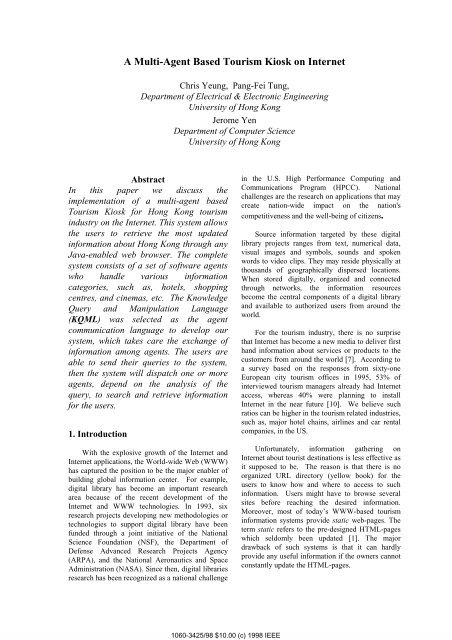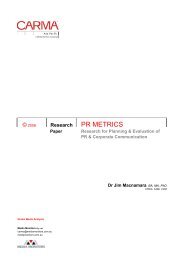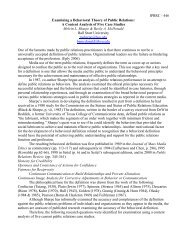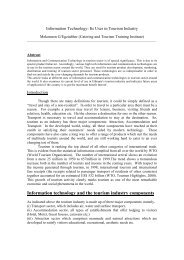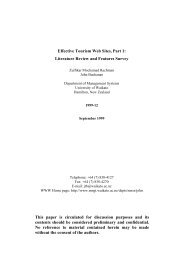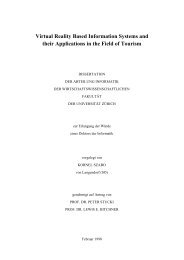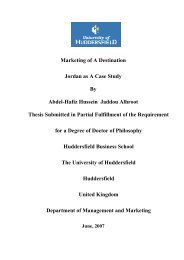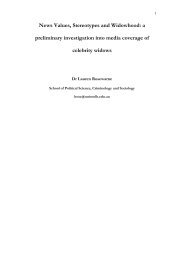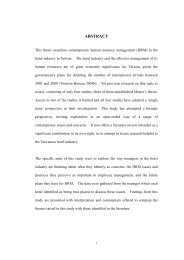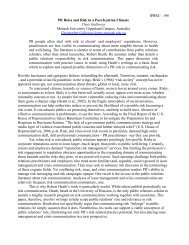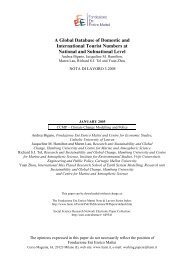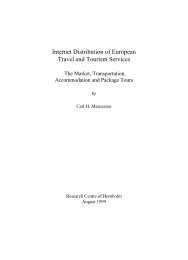A Multi-Agent Based Tourism Kiosk on Internet
A Multi-Agent Based Tourism Kiosk on Internet
A Multi-Agent Based Tourism Kiosk on Internet
You also want an ePaper? Increase the reach of your titles
YUMPU automatically turns print PDFs into web optimized ePapers that Google loves.
A <str<strong>on</strong>g>Multi</str<strong>on</strong>g>-<str<strong>on</strong>g>Agent</str<strong>on</strong>g> <str<strong>on</strong>g>Based</str<strong>on</strong>g> <str<strong>on</strong>g>Tourism</str<strong>on</strong>g> <str<strong>on</strong>g>Kiosk</str<strong>on</strong>g> <strong>on</strong> <strong>Internet</strong><br />
Chris Yeung, Pang-Fei Tung,<br />
Department of Electrical & Electr<strong>on</strong>ic Engineering<br />
University of H<strong>on</strong>g K<strong>on</strong>g<br />
Jerome Yen<br />
Department of Computer Science<br />
University of H<strong>on</strong>g K<strong>on</strong>g<br />
Abstract<br />
In this paper we discuss the<br />
implementati<strong>on</strong> of a multi-agent based<br />
<str<strong>on</strong>g>Tourism</str<strong>on</strong>g> <str<strong>on</strong>g>Kiosk</str<strong>on</strong>g> for H<strong>on</strong>g K<strong>on</strong>g tourism<br />
industry <strong>on</strong> the <strong>Internet</strong>. This system allows<br />
the users to retrieve the most updated<br />
informati<strong>on</strong> about H<strong>on</strong>g K<strong>on</strong>g through any<br />
Java-enabled web browser. The complete<br />
system c<strong>on</strong>sists of a set of software agents<br />
who handle various informati<strong>on</strong><br />
categories, such as, hotels, shopping<br />
centres, and cinemas, etc. The Knowledge<br />
Query and Manipulati<strong>on</strong> Language<br />
(KQML) was selected as the agent<br />
communicati<strong>on</strong> language to develop our<br />
system, which takes care the exchange of<br />
informati<strong>on</strong> am<strong>on</strong>g agents. The users are<br />
able to send their queries to the system,<br />
then the system will dispatch <strong>on</strong>e or more<br />
agents, depend <strong>on</strong> the analysis of the<br />
query, to search and retrieve informati<strong>on</strong><br />
for the users.<br />
1. Introducti<strong>on</strong><br />
With the explosive growth of the <strong>Internet</strong> and<br />
<strong>Internet</strong> applicati<strong>on</strong>s, the World-wide Web (WWW)<br />
has captured the positi<strong>on</strong> to be the major enabler of<br />
building global informati<strong>on</strong> center. For example,<br />
digital library has become an important research<br />
area because of the recent development of the<br />
<strong>Internet</strong> and WWW technologies. In 1993, six<br />
research projects developing new methodologies or<br />
technologies to support digital library have been<br />
funded through a joint initiative of the Nati<strong>on</strong>al<br />
Science Foundati<strong>on</strong> (NSF), the Department of<br />
Defense Advanced Research Projects Agency<br />
(ARPA), and the Nati<strong>on</strong>al Aer<strong>on</strong>autics and Space<br />
Administrati<strong>on</strong> (NASA). Since then, digital libraries<br />
research has been recognized as a nati<strong>on</strong>al challenge<br />
1060-3425/98 $10.00 (c) 1998 IEEE<br />
in the U.S. High Performance Computing and<br />
Communicati<strong>on</strong>s Program (HPCC). Nati<strong>on</strong>al<br />
challenges are the research <strong>on</strong> applicati<strong>on</strong>s that may<br />
create nati<strong>on</strong>-wide impact <strong>on</strong> the nati<strong>on</strong>'s<br />
competitiveness and the well-being of citizens<br />
Source informati<strong>on</strong> targeted by these digital<br />
library projects ranges from text, numerical data,<br />
visual images and symbols, sounds and spoken<br />
words to video clips. They may reside physically at<br />
thousands of geographically dispersed locati<strong>on</strong>s.<br />
When stored digitally, organized and c<strong>on</strong>nected<br />
through networks, the informati<strong>on</strong> resources<br />
become the central comp<strong>on</strong>ents of a digital library<br />
and available to authorized users from around the<br />
world.<br />
For the tourism industry, there is no surprise<br />
that <strong>Internet</strong> has become a new media to deliver first<br />
hand informati<strong>on</strong> about services or products to the<br />
customers from around the world [7]. According to<br />
a survey based <strong>on</strong> the resp<strong>on</strong>ses from sixty-<strong>on</strong>e<br />
European city tourism offices in 1995, 53% of<br />
interviewed tourism managers already had <strong>Internet</strong><br />
access, whereas 40% were planning to install<br />
<strong>Internet</strong> in the near future [10]. We believe such<br />
ratios can be higher in the tourism related industries,<br />
such as, major hotel chains, airlines and car rental<br />
companies, in the US.<br />
Unfortunately, informati<strong>on</strong> gathering <strong>on</strong><br />
<strong>Internet</strong> about tourist destinati<strong>on</strong>s is less effective as<br />
it supposed to be. The reas<strong>on</strong> is that there is no<br />
organized URL directory (yellow book) for the<br />
users to know how and where to access to such<br />
informati<strong>on</strong>. Users might have to browse several<br />
sites before reaching the desired informati<strong>on</strong>.<br />
Moreover, most of today’s WWW-based tourism<br />
informati<strong>on</strong> systems provide static web-pages. The<br />
term static refers to the pre-designed HTML-pages<br />
which seldomly been updated [1]. The major<br />
drawback of such systems is that it can hardly<br />
provide any useful informati<strong>on</strong> if the owners cannot<br />
c<strong>on</strong>stantly update the HTML-pages.
In order to solve such problem, we propose a<br />
multi-agent based tourism kiosk which runs <strong>on</strong> the<br />
<strong>Internet</strong> and aims at enhancing the effectiveness and<br />
efficiency of informati<strong>on</strong> retrieval <strong>on</strong> tourism<br />
informati<strong>on</strong>. Moreover, the fr<strong>on</strong>t-end, which is a<br />
kiosk – a special interactive graphical user interface<br />
(GUI), has been developed to allow the users to<br />
enter their queries and to trace the searching and<br />
retrieval of the informati<strong>on</strong>. The informati<strong>on</strong> and<br />
data about city, hotels, and other items which are<br />
important to the tourists, are stored <strong>on</strong> several<br />
distributed databases.<br />
In this system, a group of software agents have<br />
been developed with KQML and Java to work<br />
cooperatively with each other similar to that of the<br />
informati<strong>on</strong> desks in various tourism related<br />
industries or services, such as, hotel and Mass<br />
Transit Railway (MTR). Although the system has<br />
been implemented <strong>on</strong>ly to support a specific<br />
geographic area, i.e. H<strong>on</strong>g K<strong>on</strong>g, it is truly portable<br />
and scalable. The system was developed with the<br />
objected-oriented approach and that provides a<br />
great flexibility to the future expansi<strong>on</strong> or<br />
migrati<strong>on</strong>. Only few modificati<strong>on</strong>s are required to<br />
migrate the kiosk to other regi<strong>on</strong>s.<br />
In secti<strong>on</strong> 2, we will discuss briefly about the<br />
multi-agent systems. Technologies that used to<br />
develop the multi-agent system will be discussed in<br />
secti<strong>on</strong> 3. Architecture of the agent-based tourism<br />
society will be discussed in secti<strong>on</strong> 4.<br />
Implementati<strong>on</strong> will be discussed in secti<strong>on</strong> 5. This<br />
paper is c<strong>on</strong>cluded with some discussi<strong>on</strong>s about the<br />
limitati<strong>on</strong>s of the multi-agent system and<br />
recommendati<strong>on</strong>s for future research.<br />
2. <str<strong>on</strong>g>Multi</str<strong>on</strong>g>-<str<strong>on</strong>g>Agent</str<strong>on</strong>g> System<br />
Software agents, especially multi-agent<br />
systems, have become an important research topic<br />
recently. The term agent has been used widely in<br />
many different areas, from pers<strong>on</strong>al assistants [6]<br />
and smart interfaces [3], to intelligent informati<strong>on</strong><br />
retrieval systems [9] and intelligent searching<br />
spiders. Although a firm definiti<strong>on</strong> <strong>on</strong> agent has not<br />
been agreed up<strong>on</strong>, most works accept that an agent<br />
should have the following properties:<br />
�� Aut<strong>on</strong>omy: agents should be able to operate<br />
without direct human’s interventi<strong>on</strong>, and have<br />
certain c<strong>on</strong>trol over their acti<strong>on</strong>s and how to<br />
reach their goals [2].<br />
�<br />
�� Social ability: agents should be able to<br />
communicate with other agents via agentcommunicati<strong>on</strong><br />
language in order to share<br />
informati<strong>on</strong> or exchange messages [5, 8].<br />
1060-3425/98 $10.00 (c) 1998 IEEE<br />
�<br />
�� Reactivity: agents should be able to perceive<br />
changes occurred in the envir<strong>on</strong>ment, and<br />
resp<strong>on</strong>d to such changes [11].<br />
In our multi-agent system, the agents are<br />
basically independent software processes, which are<br />
run fully distributed and aut<strong>on</strong>omously. Each agent<br />
has a special task to perform and special goal to<br />
achieve. <str<strong>on</strong>g>Agent</str<strong>on</strong>g>s are able to communicate with each<br />
other and resp<strong>on</strong>d to the change of the envir<strong>on</strong>ment.<br />
The agents in our system use Knowledge Query and<br />
Manipulati<strong>on</strong> Language (KQML) [4] as the<br />
communicati<strong>on</strong> language to communicate, that is,<br />
send or receive messages, with other agents.<br />
Through the development and test of these<br />
coordinated agents, it is possible to explore the<br />
feasibility of building a totally aut<strong>on</strong>omous agentbased<br />
society to support tourism industry.<br />
3. Technology Platform<br />
The most important design criteri<strong>on</strong> of our<br />
system is platform independence. All core system<br />
comp<strong>on</strong>ents, which include: behaviour of agents and<br />
protocols of communicati<strong>on</strong>, searching and retrieval<br />
of informati<strong>on</strong> <strong>on</strong> the distributed databases, and<br />
interface for end-users which can be accessed<br />
through <strong>Internet</strong>, are all developed using the Java or<br />
other technologies which are platform independent.<br />
The linkages am<strong>on</strong>g the comp<strong>on</strong>ents or various<br />
agents are provided by the KQML, which<br />
encapsulates all the necessary message passing and<br />
communicati<strong>on</strong> capabilities which are needed by<br />
our system.<br />
3.1. <str<strong>on</strong>g>Agent</str<strong>on</strong>g> Messaging �� KQML<br />
In order to provide an effective, c<strong>on</strong>structive<br />
and intelligent interacti<strong>on</strong> am<strong>on</strong>g software agents, a<br />
comm<strong>on</strong> understanding of the terms used in the<br />
given c<strong>on</strong>text is required. This implies that there is a<br />
need for three fundamental and distinct<br />
characteristics [4]: a comm<strong>on</strong> language for all the<br />
agents; a comm<strong>on</strong> understanding of how the<br />
knowledge or messages are exchanged over<br />
<strong>Internet</strong>; and the mechanism to support the<br />
exchange of the first two items.<br />
The Knowledge Query and Manipulati<strong>on</strong><br />
Language (KQML) is a language for exchanging<br />
informati<strong>on</strong> and knowledge am<strong>on</strong>g software agents<br />
over the network. It was developed by the ARPA as<br />
part of the ARPA Knowledge Sharing Effort, which<br />
aimed at developing techniques and methodology<br />
for building large-scale knowledge bases with<br />
sharable and reusable properties. It should be<br />
noticed that KQML is not a transport protocol like
http or ftp. It is a message format as well as a<br />
message-handling protocol to support run-time<br />
knowledge sharing am<strong>on</strong>g agents. The language<br />
allows an agent to interact with other agents in a<br />
c<strong>on</strong>fined envir<strong>on</strong>ment or to share knowledge or<br />
informati<strong>on</strong> to support complex problem solving in<br />
an agent society.<br />
For example, a KQML message generated by<br />
an agent to look up room prices of a hotel may be<br />
encoded as following:<br />
(ask-price:sender agent<br />
:receiver hotel-server<br />
:<strong>on</strong>tology TOURISM<br />
:c<strong>on</strong>tent (room-price<br />
:name Hotel_A<br />
:room twin<br />
)<br />
)<br />
The above KQML message can be divided into<br />
three layers:<br />
1. The c<strong>on</strong>tent layer, designated by the :c<strong>on</strong>tent<br />
keyword to describe the message data itself;<br />
2. The communicati<strong>on</strong> layer which describes lower<br />
level communicati<strong>on</strong> parameters through the :sender<br />
and :receiver pairs; and<br />
3. The message layer, denoted by the value of<br />
:<strong>on</strong>tology, determines the kind of interacti<strong>on</strong>s <strong>on</strong>e can<br />
have with a KQML-c<strong>on</strong>formance agent.<br />
As illustrated in the above example, KQML is<br />
highly generic and neutral. KQML separates the<br />
c<strong>on</strong>tents of the messages and the c<strong>on</strong>texts about how<br />
the messages should be interpreted or executed.<br />
KQML does not attempt to understand the c<strong>on</strong>tents<br />
of the messages, but it detects how the messages<br />
should be delivered and what to do when a message<br />
reaches the other end. It is up to the corresp<strong>on</strong>ding<br />
agent to interpret the message c<strong>on</strong>tent based <strong>on</strong> the<br />
informati<strong>on</strong> about the c<strong>on</strong>text.<br />
3.2. <str<strong>on</strong>g>Agent</str<strong>on</strong>g> Behavior �� JATLite/JAT_0.3<br />
JATLite/JAT_0.3, developed by the Stanford<br />
University, is the core of the multi-agent<br />
development tools that used in our multi-agent<br />
system. It provides a set of fully functi<strong>on</strong>al<br />
templates. It is written entirely in the Java language<br />
which supports the c<strong>on</strong>structi<strong>on</strong> of software agents<br />
that able to communicate peer-to-peer with other<br />
agents through the <strong>Internet</strong>. Such envir<strong>on</strong>ment that<br />
c<strong>on</strong>sists of software agents is called agent<br />
community. All agent messages use KQML as a<br />
top-level protocol or message wrapper. The<br />
architecture of the JAT was specifically designed to<br />
allow the replacement and specialisati<strong>on</strong> of major<br />
functi<strong>on</strong>al comp<strong>on</strong>ents, which include the GUI, lowlevel<br />
messaging, message interpretati<strong>on</strong>, and<br />
resource handling. C<strong>on</strong>sequently, it is desirable to<br />
1060-3425/98 $10.00 (c) 1998 IEEE<br />
use JAT as a platform to develop a wide range of<br />
agents to support different applicati<strong>on</strong> domains.<br />
3.3. <str<strong>on</strong>g>Agent</str<strong>on</strong>g> Informati<strong>on</strong> Management ��<br />
JDBC<br />
Every agent in the society must be able to<br />
access real-time informati<strong>on</strong> in various levels of<br />
details subject to its behaviour and security<br />
c<strong>on</strong>straints. The informati<strong>on</strong> is best captured in<br />
database systems which support the distributed<br />
processing and data security across private networks<br />
and <strong>Internet</strong>. In order to guarantee that any agent be<br />
able to be c<strong>on</strong>nected to a specific database engine,<br />
the Java DataBase C<strong>on</strong>nectivity (JDBC)<br />
programming interface has been selected to meet the<br />
requirement of vendor independence. In the actual<br />
implementati<strong>on</strong>, all informati<strong>on</strong> are managed by the<br />
mSQL 1 . Which is a lightweight database engine<br />
designed to provide fast access to stored data with<br />
low memory requirements. It also has been<br />
designed to work in a client/server envir<strong>on</strong>ment<br />
over a TCP/IP network.<br />
4. Architecture of <str<strong>on</strong>g>Agent</str<strong>on</strong>g>-based Society<br />
In this secti<strong>on</strong> we will provide an overview<br />
about the system architecture of our multi-agent<br />
system. At the present stage, a prototype of an agent<br />
society has been developed as shown in Figure 1.<br />
There are four fundamental agents in this agent<br />
society, namely Informati<strong>on</strong> <str<strong>on</strong>g>Agent</str<strong>on</strong>g> (IA); <str<strong>on</strong>g>Agent</str<strong>on</strong>g><br />
Name Server (ANS); Category Group <str<strong>on</strong>g>Agent</str<strong>on</strong>g><br />
(CGA); and Client <str<strong>on</strong>g>Agent</str<strong>on</strong>g> (CA). Most applicati<strong>on</strong>s<br />
can be developed by defining agents <strong>on</strong> the top level<br />
through the inheritance property enforced by the<br />
object-oriented methodologies. The framework of<br />
this agent society more or less can be specified by<br />
the coordinating manner of the agents. The behavior<br />
of each agent is described below:<br />
Informati<strong>on</strong> <str<strong>on</strong>g>Agent</str<strong>on</strong>g> (IA)<br />
�� It is the basic entity of the agent society, which<br />
is resided in any site that interested in offering<br />
services, such as, tourism informati<strong>on</strong> of hotels.<br />
�� It must be able to access data that stored locally<br />
in order to process the queries that come from<br />
other agents.<br />
�� A site may opti<strong>on</strong>ally limits the agents to access<br />
to n<strong>on</strong>-critical data <strong>on</strong>ly (address, ph<strong>on</strong>e<br />
number, pricing or types of room services in<br />
case of a hotel) which are also available to<br />
other IAs.<br />
�� Once invoked, an IA must register itself to the<br />
ANS (will be discussed below) and be ready to<br />
1 mSQL is a public domain software from Hughes Technologies
offer services to other agents.<br />
<str<strong>on</strong>g>Agent</str<strong>on</strong>g> Name Server (ANS)<br />
�� It is the core agent to maintain and coordinate a<br />
list of informati<strong>on</strong> agents, which are<br />
categorized into groups according to the types<br />
of informati<strong>on</strong> these agents provide.<br />
�� It spawns a CGA (to be discussed below) to<br />
handle those IAs in the same category.<br />
�� It acts as a communicati<strong>on</strong> channel for a set of<br />
cooperating agents under the c<strong>on</strong>diti<strong>on</strong> that<br />
Client<br />
<str<strong>on</strong>g>Agent</str<strong>on</strong>g><br />
(CA)<br />
Informati<strong>on</strong><br />
<str<strong>on</strong>g>Agent</str<strong>on</strong>g><br />
(IA)<br />
WWW-Client<br />
Informati<strong>on</strong><br />
<str<strong>on</strong>g>Agent</str<strong>on</strong>g><br />
(IA)<br />
<strong>Internet</strong><br />
<str<strong>on</strong>g>Agent</str<strong>on</strong>g> Name Server<br />
(ANS)<br />
Figure 1. Architecture of the agent society<br />
Category Group <str<strong>on</strong>g>Agent</str<strong>on</strong>g> (CGA)<br />
�� It is an agent that performs likes a proxy server<br />
to reduce the workload of ANS and to provide<br />
data cache for the IAs in the same category.<br />
This agent follows an object-oriented design<br />
template, which encourages the creati<strong>on</strong> of a<br />
group object to assure that the same behavior<br />
can be created in its subordinated objects.<br />
�� Once the CGA is created, the ANS<br />
communicates with the CGA directly instead of<br />
the IA for data or informati<strong>on</strong>. When ANS<br />
submits a request to a CGA, the CGA will<br />
check the data in the cache first before asking<br />
the IAs to search for the informati<strong>on</strong> required.<br />
Therefore it helps reducing network traffics and<br />
improves the overall system performance. The<br />
improvement is more significant if a slow<br />
c<strong>on</strong>necti<strong>on</strong> between the ANS and an IA does<br />
exist.<br />
there may be site-specific security restricti<strong>on</strong>s,<br />
which forbid direct path of agent dialogue . For<br />
example, the Java applet embedded in the<br />
HTML page is allowed to make c<strong>on</strong>necti<strong>on</strong> to<br />
the single site from which it was downloaded<br />
<strong>on</strong>ly in most Java-enabled browser.<br />
Category Group<br />
<str<strong>on</strong>g>Agent</str<strong>on</strong>g>(CGA)<br />
1060-3425/98 $10.00 (c) 1998 IEEE<br />
Informati<strong>on</strong><br />
<str<strong>on</strong>g>Agent</str<strong>on</strong>g><br />
(IA)<br />
of Hotel c<br />
same category group<br />
Informati<strong>on</strong><br />
<str<strong>on</strong>g>Agent</str<strong>on</strong>g><br />
(IA)<br />
of Hotel a<br />
Informati<strong>on</strong><br />
<str<strong>on</strong>g>Agent</str<strong>on</strong>g><br />
(IA)<br />
of Hotel b<br />
Client <str<strong>on</strong>g>Agent</str<strong>on</strong>g> (CA)<br />
�� A CA handles all end-user queries and the<br />
interface with the ANS, which in turns<br />
dispatches agents to serve the queries.<br />
�� We can classify the CA as the format of a Java<br />
applet that embedded in the HTML page and<br />
be able to be downloaded <strong>on</strong> the user’s machine<br />
for executi<strong>on</strong>. The applet provides the GUI and<br />
assists the user in the browsing of the<br />
informati<strong>on</strong> that returned by the IAs. We have<br />
implemented such applets with digital map<br />
technology, which speeds up the display and<br />
manipulati<strong>on</strong> of geographic informati<strong>on</strong> by an<br />
order of magnitude. In secti<strong>on</strong> 6, we will<br />
describe this CA applet with emphasis <strong>on</strong> userfriendliness.<br />
Figure 2 illustrates the two most active<br />
communicati<strong>on</strong> phases am<strong>on</strong>g various agents. The<br />
ANS remains passive most of the time until either a
new IA requests for registrati<strong>on</strong> or a CA intends to<br />
forward a query. The registrati<strong>on</strong> activity is called<br />
the society binding phase and the query activity is<br />
performed during the informati<strong>on</strong> retrieving phase.<br />
Once a CA c<strong>on</strong>necti<strong>on</strong> is granted, the ANS will<br />
inform the CA about all initially available services<br />
through the IAs. All subsequent queries are either<br />
going through the ANS or the cached CGA before<br />
reaching those IAs c<strong>on</strong>cerned.<br />
potential user<br />
(CA)<br />
C<strong>on</strong>nect<br />
initial data<br />
informati<strong>on</strong> request<br />
informati<strong>on</strong><br />
informati<strong>on</strong> request<br />
informati<strong>on</strong><br />
Close<br />
coordinator<br />
(ANS, CGA)<br />
registrati<strong>on</strong><br />
accepted<br />
registrati<strong>on</strong><br />
accepted<br />
.<br />
.<br />
.<br />
ask initial data<br />
initial data<br />
informati<strong>on</strong> request<br />
informati<strong>on</strong><br />
informati<strong>on</strong><br />
cached in<br />
CGA<br />
potential informati<strong>on</strong><br />
provider (IA)<br />
a new<br />
IA<br />
a new<br />
IA<br />
society binding<br />
phase<br />
registrated<br />
IAs<br />
informati<strong>on</strong><br />
retrieving<br />
phase<br />
corresp<strong>on</strong>ding<br />
IA<br />
Figure 2: <str<strong>on</strong>g>Agent</str<strong>on</strong>g> communicati<strong>on</strong> phases<br />
4.1. Tourist Society �� A Scenario<br />
To better explain how the above architecture<br />
serves as an agent society for tourism, we will walk<br />
through the process that involved a retrieval of the<br />
detail informati<strong>on</strong> about the Park Lane Hotel for a<br />
user.<br />
Figure 3 depicts the four process flows am<strong>on</strong>g<br />
the agents as follows:<br />
(1) A Client <str<strong>on</strong>g>Agent</str<strong>on</strong>g> sends a KQML message to the<br />
ANS according to the request from the enduser:<br />
(evaluate :sender Client-<str<strong>on</strong>g>Agent</str<strong>on</strong>g>908<br />
:receiver ANS<br />
:language KQML<br />
:<strong>on</strong>tology HKMap<br />
:c<strong>on</strong>tent (ask-detail<br />
:type hotel<br />
:name (Park Lane Hotel)<br />
:maparea (Causeway Bay)<br />
1060-3425/98 $10.00 (c) 1998 IEEE<br />
)<br />
)<br />
(2) The ANS first searches through the resource<br />
table to find out which IA has the informati<strong>on</strong><br />
<strong>on</strong> Park Lane Hotel , then ANS will send a<br />
KQML message to that IA for informati<strong>on</strong>;<br />
(evaluate :sender ANS<br />
:receiver <str<strong>on</strong>g>Agent</str<strong>on</strong>g>-A<br />
:language KQML<br />
:<strong>on</strong>tology HKMap<br />
:c<strong>on</strong>tent (ask-detail<br />
:from Client-<str<strong>on</strong>g>Agent</str<strong>on</strong>g>908<br />
:type hotel<br />
:data (Park Lane Hotel)<br />
:maparea (Causeway Bay)<br />
)<br />
)<br />
If a CGA of hotel exists , ANS will send this<br />
KQML message to the CGA directly without<br />
searching through the table.<br />
(3) The IA (<str<strong>on</strong>g>Agent</str<strong>on</strong>g>-A) sends the result from the<br />
database back to the ANS;<br />
(evaluate :sender <str<strong>on</strong>g>Agent</str<strong>on</strong>g>-A<br />
:receiver ANS<br />
:language KQML<br />
:<strong>on</strong>tology HKMap<br />
:c<strong>on</strong>tent (tell-detail<br />
:from Client-<str<strong>on</strong>g>Agent</str<strong>on</strong>g>908<br />
:type hotel<br />
:data (Park Lane Hotel)<br />
:maparea (Causeway Bay)<br />
:result ([4][address : 129 , Liu To Road<br />
, Causeway Bay][tel :<br />
(852)2745617][Price of room A:<br />
HK$ 700/ per day][Price of<br />
room B: HK$1000/ per day]<br />
)<br />
)<br />
)<br />
(4) ANS sends the received result back to CA , and<br />
CA displays the result to the user.<br />
Client <str<strong>on</strong>g>Agent</str<strong>on</strong>g><br />
(4) (1)<br />
<str<strong>on</strong>g>Agent</str<strong>on</strong>g> Name Server<br />
(ANS)<br />
Informati<strong>on</strong> <str<strong>on</strong>g>Agent</str<strong>on</strong>g><br />
(IA) Informati<strong>on</strong> <str<strong>on</strong>g>Agent</str<strong>on</strong>g><br />
(IA)<br />
(2)<br />
(3)<br />
Informati<strong>on</strong> <str<strong>on</strong>g>Agent</str<strong>on</strong>g><br />
(<str<strong>on</strong>g>Agent</str<strong>on</strong>g>-A)<br />
Hotel<br />
Databa<br />
se<br />
Figure 3.Communicati<strong>on</strong> processes for a Hotel<br />
query
<str<strong>on</strong>g>Agent</str<strong>on</strong>g><br />
KQML<br />
message<br />
KQML<br />
message<br />
<str<strong>on</strong>g>Agent</str<strong>on</strong>g><br />
Communicati<strong>on</strong><br />
interface<br />
5. <str<strong>on</strong>g>Agent</str<strong>on</strong>g> modelling and Implementati<strong>on</strong><br />
The four agent entities described in the<br />
previous secti<strong>on</strong> all inherit from an abstract agent<br />
object model (Figure 4). This agent model c<strong>on</strong>sists<br />
of four major comp<strong>on</strong>ents: a KQML message<br />
interpreter, a set resource allocati<strong>on</strong> methods, a set<br />
of c<strong>on</strong>trol policies, and a communicati<strong>on</strong> interface.<br />
5.1. Resource Allocati<strong>on</strong><br />
Every agent requires different resources. Some<br />
require incoming and outgoing system buffers and<br />
some need accessing and managing <strong>on</strong>tology<br />
interpreters. These resources have been organised<br />
as a hierarchy of hash tables for efficient access. It<br />
is important to understand that this hierarchy dose<br />
provide informati<strong>on</strong> about where and how an agent<br />
receives informati<strong>on</strong> in order to exhibit aut<strong>on</strong>omous<br />
behaviour. For example, before an agent is able to<br />
start a communicati<strong>on</strong> to another agent, it needs to<br />
know the actual IP address of the receiver by<br />
searching through the agent table in the resource<br />
allocati<strong>on</strong>.<br />
Table 1. Resource tables<br />
Resource Allocati<strong>on</strong> HashTable<br />
Keyword (String) Value (Java Object)<br />
“message buffer” KQMLmessage<br />
“interpreter” Ontology Interpreter<br />
HashTable<br />
“agent table” Cooperating <str<strong>on</strong>g>Agent</str<strong>on</strong>g><br />
HashTable<br />
KQML<br />
message<br />
Interpreter<br />
Data<br />
Figure.4. <str<strong>on</strong>g>Agent</str<strong>on</strong>g> object model<br />
1060-3425/98 $10.00 (c) 1998 IEEE<br />
<str<strong>on</strong>g>Agent</str<strong>on</strong>g><br />
Resource Allocati<strong>on</strong> :<br />
incoming buffer<br />
outgoing buffer<br />
<strong>on</strong>tology interpreters<br />
addresses of other agents<br />
Policy C<strong>on</strong>trol :<br />
Service policy<br />
Envir<strong>on</strong>ment policy<br />
Security policy<br />
Ontology Interpreter HashTable<br />
Keyword (String) Value (Interpreter<br />
object)<br />
“database”<br />
DatabaseInterpreter.class<br />
“HKMap”<br />
HKMapInterpreter.class<br />
“agent”<br />
<str<strong>on</strong>g>Agent</str<strong>on</strong>g>Interpreter.class<br />
Table 1 shows a simplified two-level structure<br />
for resource allocati<strong>on</strong>. The top table incorporates<br />
two other hash tables, <strong>on</strong>e for managing <strong>on</strong>tology<br />
interpreters and the other for maintaining links with<br />
other cooperative agents. The bottom table instructs<br />
an agent to locate the necessary interpreter for every<br />
<strong>on</strong>tology in the KQML message. For example, if a<br />
message has an :<strong>on</strong>tology value of “database”, then<br />
the Java interpreter DatabaseInterpreter.class will be<br />
loaded to decrypt and process the :c<strong>on</strong>tent part of the<br />
message. It should be noted that an interpreter can<br />
be located at any internet site other than the place<br />
where the agent resides.<br />
5.2. KQML Message Interpreter<br />
Once an incoming KQML message is detected,<br />
it will be passed to the KQML message interpreter<br />
through the communicati<strong>on</strong> interface. The<br />
interpreter first determines whether the sender of the<br />
message is an already known agent or a new agent.<br />
If it is a new agent the interpreter will update the<br />
resource table by including the new agent. Then the<br />
interpreter dissembles the KQML message into<br />
tuples of keywords and value pairs. After that, the<br />
interpreter will try to interpret the message<br />
according to the specified <strong>on</strong>tology (the message<br />
layer of KQML) by loading the matched <strong>on</strong>tology<br />
interpreter, which is the element in the agent<br />
resource field. The following is the sample Java<br />
code used in the interpreter:
String Ontology = KQMLmessage.getValue(“<strong>on</strong>tology”);<br />
Interpreter = (Interpreter)(agent.getResource(“interpreter”<br />
)).getElement(Ontology);<br />
For each <strong>on</strong>tology interpreter, the message is<br />
interpreted according to the c<strong>on</strong>tent layer c<strong>on</strong>tained.<br />
For example, c<strong>on</strong>sider the following KQML<br />
message:<br />
(evaluate :sender <str<strong>on</strong>g>Agent</str<strong>on</strong>g>-A<br />
:receiver <str<strong>on</strong>g>Agent</str<strong>on</strong>g>-B<br />
:<strong>on</strong>tology database<br />
:c<strong>on</strong>tent (update-data<br />
:name Hotel-DB<br />
:item 302<br />
:value 500<br />
)<br />
)<br />
The KQML message interpreter of <str<strong>on</strong>g>Agent</str<strong>on</strong>g>-B<br />
will load the <strong>on</strong>tology interpreter of database to<br />
interpret the c<strong>on</strong>tent layer of the above message. As<br />
a result, the item 302 in the database Hotel-DB will<br />
be updated by <str<strong>on</strong>g>Agent</str<strong>on</strong>g>-B.<br />
Therefore, an agent can have different <strong>on</strong>tology<br />
interpreters to handle different task or request. Each<br />
of these <strong>on</strong>tology interpreters actually implements<br />
the knowledge that agent is supposed to have <strong>on</strong> a<br />
particular subject. Using the Java technology, an<br />
interpreter can be downloaded during runtime to<br />
guarantee the access of most updated informati<strong>on</strong><br />
any time.<br />
5.3. Policy C<strong>on</strong>trol<br />
At current stage, there are three aspects of the<br />
c<strong>on</strong>trol policies <strong>on</strong> the behaviour of an agent.<br />
1) Service policy c<strong>on</strong>trols the availability of the<br />
services provided by a certain agent. For<br />
example, some services from an agent may be<br />
available <strong>on</strong>ly during office hours, otherwise<br />
the agent simply rejects c<strong>on</strong>necti<strong>on</strong> requests<br />
from other agents for these services.<br />
2) Envir<strong>on</strong>ment policy c<strong>on</strong>trols the behaviour of<br />
the agent <strong>on</strong> varying envir<strong>on</strong>mental parameters.<br />
For example, the IA in our multi-agent system<br />
will try to detect the c<strong>on</strong>necti<strong>on</strong> state to ANS<br />
periodically. In case that the ANS is down, the<br />
IA will try to register itself again automatically<br />
when the ANS is rebooted.<br />
3) Security policy has always been a serious issue<br />
in any networked computer system. In a multiagent<br />
system, there are security requirements <strong>on</strong><br />
the services that provided by the system. This<br />
implies that a service from a particular agent<br />
will be made available if and <strong>on</strong>ly if certain<br />
security c<strong>on</strong>straints have been met. For<br />
example, c<strong>on</strong>sider the following situati<strong>on</strong> as<br />
shown in Figure 5.<br />
<str<strong>on</strong>g>Agent</str<strong>on</strong>g>-E<br />
<str<strong>on</strong>g>Agent</str<strong>on</strong>g>-F<br />
1060-3425/98 $10.00 (c) 1998 IEEE<br />
A sample office<br />
network<br />
<str<strong>on</strong>g>Agent</str<strong>on</strong>g>-D<br />
Data<br />
<str<strong>on</strong>g>Agent</str<strong>on</strong>g>-A<br />
<str<strong>on</strong>g>Agent</str<strong>on</strong>g>-C<br />
<str<strong>on</strong>g>Agent</str<strong>on</strong>g>-B<br />
Figure 5 : a sample multi-agent system<br />
<str<strong>on</strong>g>Agent</str<strong>on</strong>g>-D as shown above is the agent able to<br />
handle the request from other agents <strong>on</strong><br />
database. The services provided by <str<strong>on</strong>g>Agent</str<strong>on</strong>g>-D and<br />
the corresp<strong>on</strong>ding security level are listed in<br />
following table.<br />
Table 2: The service and security requirement<br />
Service Security requirement<br />
retrieve data trustful, locally<br />
update data locally<br />
The classificati<strong>on</strong> of agents in Figure 5 is listed<br />
in Table 3.<br />
Table 3: classificati<strong>on</strong> <strong>on</strong> sample agents<br />
<str<strong>on</strong>g>Agent</str<strong>on</strong>g> Name Security level<br />
<str<strong>on</strong>g>Agent</str<strong>on</strong>g>-A locally<br />
<str<strong>on</strong>g>Agent</str<strong>on</strong>g>-B locally<br />
<str<strong>on</strong>g>Agent</str<strong>on</strong>g>-C locally<br />
<str<strong>on</strong>g>Agent</str<strong>on</strong>g>-E trustful<br />
<str<strong>on</strong>g>Agent</str<strong>on</strong>g>-F untrustworthy<br />
Therefore, neither of the services would be<br />
available to <str<strong>on</strong>g>Agent</str<strong>on</strong>g>-F; <str<strong>on</strong>g>Agent</str<strong>on</strong>g>-E would <strong>on</strong>ly be<br />
able to retrieve data from <str<strong>on</strong>g>Agent</str<strong>on</strong>g>-D; all the<br />
agents in the local network as shown in Figure 5<br />
are able to retrieve data as well as update the<br />
data in database.<br />
5.4. Communicati<strong>on</strong> Interface<br />
The communicati<strong>on</strong> interface as shown in<br />
Figure 4 provides as a comm<strong>on</strong> channel for the<br />
agent to deliver and receive the KQML message<br />
from other agents through the TCP/IP network.<br />
Besides, it isolates the agent from actual network<br />
protocol by providing an abstract and encapsulated<br />
mechanism.
As menti<strong>on</strong>ed in secti<strong>on</strong> 3, Java is the<br />
programming language that was designed to work<br />
over the <strong>Internet</strong>. In fact, it is far easier to<br />
implement a network system in Java than most of<br />
other languages. For example, the following figure<br />
shows a multithreading TCP/IP socket c<strong>on</strong>necti<strong>on</strong><br />
between a server (agent) and a group of clients.<br />
new Client<br />
<strong>Internet</strong><br />
an agent<br />
ClientThread<br />
ClientThread<br />
ClientThread<br />
ClientThread<br />
host<br />
ServerSocket<br />
port<br />
Figure 6. The multithreading socket c<strong>on</strong>necti<strong>on</strong><br />
ServerSocket as shown above is a class which<br />
enables a Java system to accept c<strong>on</strong>necti<strong>on</strong>s from<br />
clients(agents) across network by opening a<br />
ServerSocket <strong>on</strong> a particular local port number.<br />
The agent(as an ANS) will hand the new<br />
c<strong>on</strong>necti<strong>on</strong> from a client to a new instance of the<br />
ClinetThread class that will receive the message<br />
from that client or agent. Hence, the agents in our<br />
system are able to handle multi-c<strong>on</strong>necti<strong>on</strong> from<br />
other agents.<br />
6. Fr<strong>on</strong>t-end Applet as Client <str<strong>on</strong>g>Agent</str<strong>on</strong>g><br />
To dem<strong>on</strong>strate the functi<strong>on</strong>ality of the multiagent<br />
kiosk system, we have implemented an<br />
<strong>Internet</strong> site to offer tourists the informati<strong>on</strong> about<br />
H<strong>on</strong>g K<strong>on</strong>g. Once a user visits our web page, it will<br />
undergo the informati<strong>on</strong> retrieving phase as<br />
described in secti<strong>on</strong> 4 (Fig. 2). Figure 7 below<br />
depicts the initial layout of the page loaded through<br />
a web browser.<br />
1060-3425/98 $10.00 (c) 1998 IEEE<br />
Figure 7. Initial layout of the <str<strong>on</strong>g>Tourism</str<strong>on</strong>g> <str<strong>on</strong>g>Kiosk</str<strong>on</strong>g><br />
The Java applet first displays an outlined map<br />
of H<strong>on</strong>g K<strong>on</strong>g, then wait for user to select any of<br />
the predefined regi<strong>on</strong>s <strong>on</strong> the map. The figure shows<br />
all the regi<strong>on</strong>s that available <strong>on</strong> the system. After a<br />
particular regi<strong>on</strong> has been selected, for example,<br />
Causeway Bay, which is <strong>on</strong>e of the busiest business<br />
districts in H<strong>on</strong>g K<strong>on</strong>g, the client agent (the applet)<br />
starts to communicate with the ANS to search for<br />
the informati<strong>on</strong> agents which can provide the<br />
tourism informati<strong>on</strong> <strong>on</strong> that particular regi<strong>on</strong>. Then,<br />
the corresp<strong>on</strong>ding informati<strong>on</strong> agents send the<br />
initial data back to the client agent through the<br />
ANS. Besides, a more detail map of Causeway Bay<br />
will be loaded and displayed to the user as shown in<br />
Figure 8.<br />
Figure 8. Browsing selected regi<strong>on</strong><br />
The map as shown above is not a scanned<br />
image of a map in the format of gif or jpeg . It is a<br />
vectorized map which c<strong>on</strong>verted from a DXF file<br />
(an AutoCad file format). The resulting map file is<br />
small in size, for example, the map of Causeway<br />
Bay is about 300K bytes in size(the original DXF<br />
file is 2M bytes in size). A special Java graphics<br />
engine embedded in the applet is used to interpret<br />
the digital map. The map can be displayed in<br />
different resoluti<strong>on</strong> according the request from user.
Therefore, the user will be able to zoom in further<br />
<strong>on</strong> the map using either the mouse drag or clicking<br />
<strong>on</strong> the zoom-in butt<strong>on</strong> placed at the left-hand side of<br />
the applet frame as shown in Figure 9. In additi<strong>on</strong>,<br />
as the user moves around the map, a small bubble<br />
text box will appear to display the name of the<br />
building or facility nears by the mouse cursor.<br />
Figure 9. Magnificati<strong>on</strong> <strong>on</strong> the digital map<br />
A user is also able to retrieve further<br />
informati<strong>on</strong> about that building or facility by<br />
clicking <strong>on</strong> the area near the text box. A frame will<br />
be popped up which, for example, will show the full<br />
address, ph<strong>on</strong>e number and other informati<strong>on</strong> about<br />
that building. The actual informati<strong>on</strong> retrieval flow<br />
can refer to 4.1. Tourist Society - A Scenario part<br />
of secti<strong>on</strong> 4 (Fig. 3). Moreover, a fast locati<strong>on</strong><br />
searching interface is also provided. By clicking <strong>on</strong><br />
any of the ic<strong>on</strong>s <strong>on</strong> the top panel of the applet<br />
(referring to Figure 9) informati<strong>on</strong> about a particular<br />
service will be retrieved and forwarded to the user.<br />
These ic<strong>on</strong>s represent the agents for buses, hotels,<br />
shopping centers, parking lots, mass transit railway<br />
(MTR), cinema theaters, and hospitals. After <strong>on</strong>e<br />
service is selected, all the related spots managed by<br />
the agent will be highlighted <strong>on</strong> the current map.<br />
Figure 10. A sample bus time table<br />
Besides, the user is also able to obtain detailed<br />
informati<strong>on</strong> in the usual way by clicking <strong>on</strong> the<br />
Search butt<strong>on</strong> located <strong>on</strong> the north panel of the<br />
applet. A frame will be popped up, and the user will<br />
be able to search through the IAs for informati<strong>on</strong> by<br />
specifying keywords or select from a default list<br />
supplied by the ANS. Figure 10 shows a sample<br />
informati<strong>on</strong> frame of a bus time table.<br />
The power of the multi-agent based tourism<br />
kiosk lies <strong>on</strong> the fact that the users are able to<br />
interact with an aut<strong>on</strong>omously agent society in a<br />
interactive and user-friendly way. The fr<strong>on</strong>t-end<br />
interface is the <strong>on</strong>ly item that can be accessed by the<br />
users. The communicati<strong>on</strong>s or exchange of<br />
messages am<strong>on</strong>g the agents are d<strong>on</strong>e at the backend.<br />
Also, each agent has a simple knowledge base.<br />
If an agent cannot locate a piece of informati<strong>on</strong>, the<br />
agent can forward the request to the other agents.<br />
This approach provides a far better way <strong>on</strong> data<br />
update and integrity for real-time tourism<br />
informati<strong>on</strong> retrieval over <strong>Internet</strong>.<br />
7. System Evaluati<strong>on</strong><br />
1060-3425/98 $10.00 (c) 1998 IEEE<br />
The prototype of the multi-agent system has<br />
been implemented. We will c<strong>on</strong>duct two<br />
experiments to test the usefulness and technical<br />
performance of the multi-agent system. The first<br />
experiment is to test the usefulness and users’<br />
satisfacti<strong>on</strong> with the system. In the pilot study, we<br />
let two groups of students: graduate students and<br />
final-year undergraduate students to test the system<br />
and give us their comments and evaluati<strong>on</strong>. We<br />
particularly ask the students to pay attenti<strong>on</strong> to the<br />
resp<strong>on</strong>se time and other attributes which are<br />
important to users of the <strong>Internet</strong> applicati<strong>on</strong>s. At<br />
the end of this year, we will formally introduce the<br />
system to the users of <strong>Internet</strong> to allow them from<br />
all over the world to access the system. By that<br />
time, we will c<strong>on</strong>duct the experiment to collect data<br />
from users to compare the multi-agent based kiosk<br />
with other traditi<strong>on</strong>al tourist informati<strong>on</strong> centers or<br />
systems that developed with other informati<strong>on</strong><br />
technologies.<br />
The sec<strong>on</strong>d experiment is a technical<br />
benchmarking. Besides the multi-agent approach,<br />
we will also develop a centralized Web database<br />
system, which is a pure client-server system. In<br />
such case, there will be no communicati<strong>on</strong> directly<br />
am<strong>on</strong>g the agents. There will be a set of functi<strong>on</strong>s,<br />
but not a set of agents. We would like to identify the<br />
differences between these two approaches in terms<br />
of, for example, resp<strong>on</strong>se time and flexibility. We<br />
believe such technical comparis<strong>on</strong> is important for<br />
us to understand the strength and limitati<strong>on</strong>s of the<br />
multi-agent approach.<br />
There are significant overheads in the<br />
processing, interpretati<strong>on</strong> and communicati<strong>on</strong> with
the KQML language. Efficiency of such multiagent<br />
system can also be limited by the traffics <strong>on</strong><br />
the network and it is important to know how much<br />
such factors affect the performance and users’<br />
satisfacti<strong>on</strong> with the multi-agent systems through<br />
experiments. We will also explore the other multiagent<br />
languages, for example, IDEAS and<br />
Telescript.<br />
8. C<strong>on</strong>clusi<strong>on</strong><br />
In this paper, we proposed and have<br />
implemented a multi-agent based tourism kiosk for<br />
the users <strong>on</strong> the <strong>Internet</strong> to support their searching<br />
and retrieval of tourism informati<strong>on</strong> about H<strong>on</strong>g<br />
K<strong>on</strong>g. By using the multi-agent approach, most of<br />
the data maintenance is automatically d<strong>on</strong>e by the<br />
informati<strong>on</strong> agents at the local tourist offices. The<br />
users will always be able to access to the most<br />
update tourism informati<strong>on</strong> about H<strong>on</strong>g K<strong>on</strong>g The<br />
kiosk would be especially useful for the users who<br />
are planning a trip to H<strong>on</strong>g K<strong>on</strong>g or who are visiting<br />
H<strong>on</strong>g K<strong>on</strong>g if they have access to the <strong>Internet</strong>.<br />
References<br />
[1] Burger F., Kroiß P., Pröll B., Richtsfeld R., Sighart<br />
H., Starck H., TIS@WEB-Database Supported Tourist<br />
Informati<strong>on</strong> <strong>on</strong> the Web. In Informati<strong>on</strong> and<br />
Communicati<strong>on</strong> Technologies in <str<strong>on</strong>g>Tourism</str<strong>on</strong>g> 1997, Springer,<br />
pp. 180-189, 1997.<br />
[2] Castelfranchi C., Guarantees for aut<strong>on</strong>omy in<br />
cognitive agent architecture . In Intelligent <str<strong>on</strong>g>Agent</str<strong>on</strong>g>s:<br />
Theories, Architectures, and Languages, pp. 56-<br />
70.Springer-Verlag:Heidelberg, Germany.<br />
[3] Etzi<strong>on</strong>i O., Weld D., A softbot-based interface to the<br />
<strong>Internet</strong>. Communicati<strong>on</strong>s of the ACM, Vol. 37, No. 7,<br />
pp. 72-79, July 1994<br />
[4] Finin T., Labrou Y., Mayfield J., KQML as an agent<br />
communicati<strong>on</strong> language, University of Maryland<br />
Baltimore County , Baltimore MD USA.<br />
[5] Harold R. E., Java Network Programming, O’Reilly<br />
& Associates, Inc., 1997<br />
[6] Maes P., <str<strong>on</strong>g>Agent</str<strong>on</strong>g>s that reduce Work and informati<strong>on</strong><br />
overload. Communicati<strong>on</strong>s of the ACM, Vol. 37, No. 7,<br />
pp. 30-40, July 1994<br />
[7] Passmann C., Pipperger W., Prof. Dr. Schertler W.,<br />
How to assess WWW-applicati<strong>on</strong>s for tourism<br />
informati<strong>on</strong> systems form the end-user perspective.<br />
Methodical design and empirical evidence. In<br />
Informati<strong>on</strong> and Communicati<strong>on</strong> Technologies in<br />
<str<strong>on</strong>g>Tourism</str<strong>on</strong>g> 1997. Springer, pp. 208-220, 1997.<br />
1060-3425/98 $10.00 (c) 1998 IEEE<br />
[8] Riecken, D., Intelligent <str<strong>on</strong>g>Agent</str<strong>on</strong>g>s. Communicati<strong>on</strong>s of<br />
the ACM, Vol. 37, No. 7, pp. 18-21, July 1994<br />
[9] Rus D., Gray R., Kotz D., Aut<strong>on</strong>omous and Adaptive<br />
agents that Gather Informati<strong>on</strong> .Dartmouth College,<br />
Hanover, NH 03755<br />
[10] Wöber K. W., Services and Functi<strong>on</strong>s of European<br />
City Tourist Office, Report of the Research and Statistics<br />
Working Group of the Federati<strong>on</strong> of European Cities’<br />
Tourist Offices (FECTO), Administrati<strong>on</strong> Board Meeting,<br />
Dublin, March 22 nd 1996.<br />
[11] Wooldridge M. J. and Jennings N., R., <str<strong>on</strong>g>Agent</str<strong>on</strong>g><br />
Theories, Architectures, and Languages: A Survey. In M.<br />
J. Woodridge and N. R. Jennings, editors, Intelligent<br />
<str<strong>on</strong>g>Agent</str<strong>on</strong>g>s. Springer-Verlag, Berlin, 1995.


